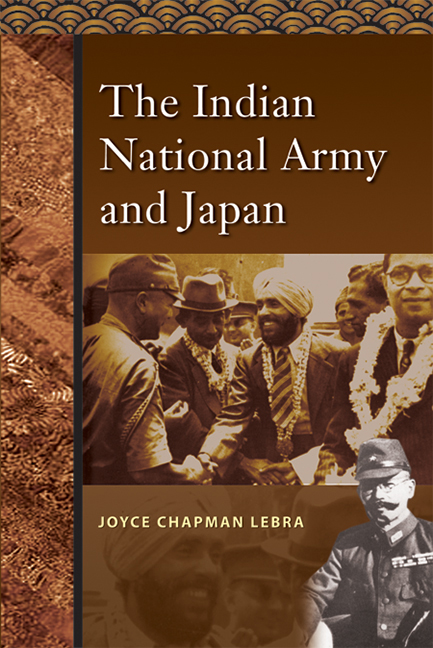Book contents
- Frontmatter
- Contents
- Illustrations and Maps
- Abstract
- Foreword
- Preface
- Acknowledgements
- Introduction
- 1 Mission to Bangkok
- 2 Malayan Jungle Meeting
- 3 Singapore Capitulates and the INA Blossoms
- 4 Tokyo Conference
- 5 Japanese Policy toward India
- 6 The Crisis of the First INA
- 7 Subhas Chandra Bose, Hitler, and Tōjō
- 8 Bose, the FIPG, and the Hikari Kikan
- 9 To India or Not?
- 10 The Rising Sun Unfurls; the Tiger Springs
- 11 A Plane Crash
- 12 A Trial in the Red Fort
- 13 Retrospect
- Notes
- Bibliographical Note
- Bibliography
- Index
- About the Author
5 - Japanese Policy toward India
Published online by Cambridge University Press: 21 October 2015
- Frontmatter
- Contents
- Illustrations and Maps
- Abstract
- Foreword
- Preface
- Acknowledgements
- Introduction
- 1 Mission to Bangkok
- 2 Malayan Jungle Meeting
- 3 Singapore Capitulates and the INA Blossoms
- 4 Tokyo Conference
- 5 Japanese Policy toward India
- 6 The Crisis of the First INA
- 7 Subhas Chandra Bose, Hitler, and Tōjō
- 8 Bose, the FIPG, and the Hikari Kikan
- 9 To India or Not?
- 10 The Rising Sun Unfurls; the Tiger Springs
- 11 A Plane Crash
- 12 A Trial in the Red Fort
- 13 Retrospect
- Notes
- Bibliographical Note
- Bibliography
- Index
- About the Author
Summary
POLICY-MAKERS IN TOKYO
Japan's wartime aims in India were never as clearly defined as her aims in Southeast Asia. India was not embraced in the grand design for the Greater East Asia Co-Prosperity Sphere first conceived in 1940. Greater East Asia would sweep through Southeast Asia westward to the Indo- Burmese border. Everywhere in Asia Western colonial rule would be driven out and independence movements encouraged. Asia for Asians became the goal and shibboleth. The Greater East Asia Co-Prosperity Sphere would constitute an economically self-sufficient entity under Japanese tutelage. Both diplomatic and military means would be employed to realize the blueprint. But Japanese military administration would respect existing local organizations and customs. By late 1941 control of resources necessary for the war effort became a focal point of the plan.
Still, India bordered the western perimeter of the Greater East Asia Co-Prosperity Sphere. And Japan was at war with the colonial power occupying India; Britain must be expelled from India. As Japan wished to see Britain purged from Asia so also Indian nationalists aspired to free India. Japan had to reckon with India for the mutual advantage of both Japan and India.
What agencies or individuals in Tokyo would do the reckoning? The Foreign Ministry was one obvious possibility. Japan had no ambassador in India under Britain, but there were consuls in the major Indian cities. In April 1941, Consul-General Okazaki in Calcutta, in a secret communiqué to Foreign Minister Matsuoka, described the independence movement of the Forward Bloc, a radical party in Bengal. Okazaki suggested establishing contact with this leftwing party in India and also with its leader, Subhas Chandra Bose, then in exile in Berlin. Going even further, he suggested, “We should secretly transport large quantities of weapons and substantially increase the actual strength of the Forward Bloc.” While Okazaki felt the movement would burgeon into a genuinely popular revolt, he felt Japan should do her part by establishing contact with Bose and aiding his party. This early Japanese notice of Bose preceded by several months Major Fujiwara's remarks about Bose to the 8th Section, Second Bureau, IGHQ.
- Type
- Chapter
- Information
- The Indian National Army and Japan , pp. 60 - 74Publisher: ISEAS–Yusof Ishak InstitutePrint publication year: 2008



